
Hair Restoration surgery risks and side effects
More and more people are undergoing hair transplants for fuller hair. However, with the increasing demand for hair surgery, the number of providers of doctors with insufficient know-how and experience is rising considerably, which ultimately means higher risks and side effects. Read here how high the risk of hair restoration surgery is, whether scars can occur in the process, where exactly the potential danger lies and what the world’s leading association ISHRS has to say about it and has even launched the “Fight the fight” campaign in the fight against the increasing number of botched operations by providers with dubious methods due to a strongly increasing number of so-called “black market” clinics worldwide!
Risks such as toilet brush look, moth-eaten and football field look, poor growth rate, wrong direction of growth, scars, cobblestoning and pitting
Hair transplantation describes an intervention on the human body and also involves risks and side effects – just as there is always a risk with all other surgical interventions in any medical field. In the field of hair transplantation these are above all in the recipient area toilet brush look, poor growth rate, wrong growth direction, scars and in the donor area moth-eaten and football field look, scars
Please also have a look at the brief overview of the hair transplant risks in the following table (the table can be scrolled to the left and right depending on the screen resolution):
| Hair transplant risks per technique | FUT strip technique | FUE technique |
|---|---|---|
| Risks in the harvesting area/donor area | Wider scar which makes it necessary to keep the hair long in the hairline. Also, the risk of a longer-lasting feeling of tension and numbness | Decimated hair crown and “overharvesting”, moth-eaten and football field appearance. As a result, this not only brings visual and aesthetic damage but also ruins the graft reserves in the donor area, with no options for the future. |
| Risks in the recipient area | With both methods Poor growth rate, unnatural hairline, thick grafts, wrong growth direction, toilet brush effect, cobblestoning and pitting | For both methods Poor growth rate, unnatural hairline, thick grafts, wrong growth direction, toilet brush effect, cobblestoning, and pitting |
In the following, you will also learn in detail about the risks you are exposed to with a hair transplant and how these can be limited in the best possible way.
Lack of training and qualification: The subject “hair transplantation” is not yet taught in any university education!
First and foremost, the choice of a suitable provider/hair surgeon determines the degree of risk. The training, qualifications, experience, and extraordinary skills of a doctor are decisive for the success of a hair restoration surgery.
A fundamental problem, however, is that in many countries and also like in Germany and Switzerland, the subject “hair surgery” is not yet taught in any university training, neither in further training to become a plastic surgeon, nor in further training on other subjects! A specialist title alone does not guarantee sufficient know-how and experience in hair transplantation and a specialist title does not guarantee a good growth rate with natural results (read also the article “best hair transplantation clinics in Germany, yes or no?)!
Furthermore, the chosen method and the instruments and/or medical devices used in this regard also contribute to the best possible hair transplantation. Intransparency with the name and quality characteristics of the performing doctor, on the other hand, increases the risks considerably! In order to keep these as low as possible, it is advisable to choose a renowned, specialized hair surgeon with outstanding skills, whose successful results are documented and/or have been documented by former patients on the Internet.
Hair transplant risks Treatment errors
The topic of hair transplantation risks and “treatment errors” is a broad field and sometimes a delicate one. Most hair transplantations involve unsightly and ugly scars, unnatural-looking hairlines with hair in the wrong direction of growth and a toilet brush look (grafts that are too thick in the front), poor and low growth rates, and, in the case of FUE surgeries in the donor area, often decimated donor areas with moth-eaten hair and a window (soccer field) look. Dissatisfied patients are quick to speak of treatment errors in the case of unsuccessful hair transplant, but treatment errors can only be assumed by laypersons. In case of doubt, only a medical report and, ultimately, a court can decide whether a treatment error has actually occurred. Nevertheless, the risk is there – and the more unknown and inexperienced a doctor is, the greater the probability of a treatment error! Here, too, the lowest risks exist when choosing a proven specialist!
what can go wrong during surgery? An overview: Scars, wrong direction of growth, toilet brush look, moth-eaten and football field look, poor growth rate
Risks in the donor area
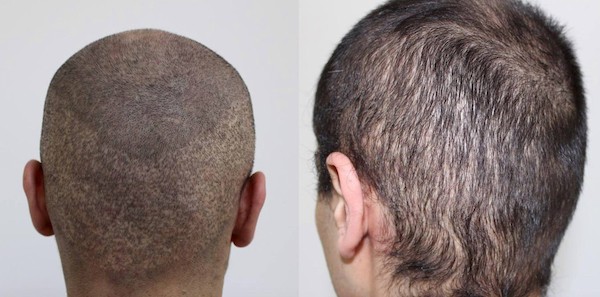
Outstanding knowledge of the surgeon is indispensable in order to guarantee a gentle and optimally distributed removal of the FUs (follicular units, grafts, hair follicles). If this is not successful, visually very unattractive appearances can remain, which are called (colloquially) “moth-eaten”.
Moth-eaten after a FUE Surgery: football field and window look
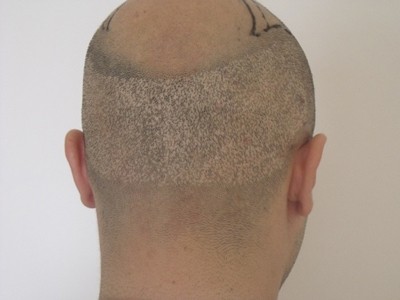
If the required grafts are harvested by machine (micromotor extraction/harvesting), there is a risk of clearly visible harvested areas resembling a “football field” or “window look” if performed by an inexperienced doctor or using a technically unsophisticated device. Patients are also exposed to the likelihood of graft damage. If relatively too many grafts are harvested, this is called “overharvesting”, which not only leaves behind the above-mentioned visual and aesthetic damage but also ruins the graft reserves in the donor area.
FUT method (harvesting through surgical skin strip removal)
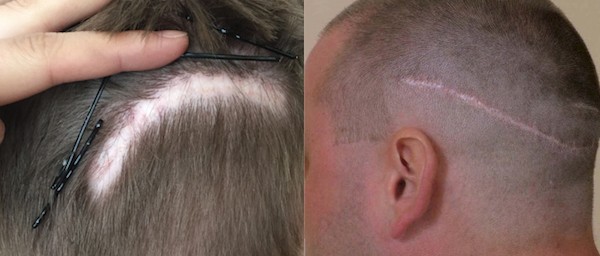
The surgical extraction of a strip of skin from the back of the head is used to obtain the required FU’s to be implanted in the recipient area. Excellent experience is also required when using this method in order to generate the grafts/hair follicles undamaged from the extracted strip. However, the patient himself also has to fear inconveniences resulting from the actual surgical removal of the strip. The surgery can leave unsightly scars, unpleasant or even painful feelings of tension can remain in the long term, and in extreme cases, weaknesses in wound healing can hinder healing.
Risks in the recipient area: unnatural frontal appearance, thick grafts, and toilet brush effect
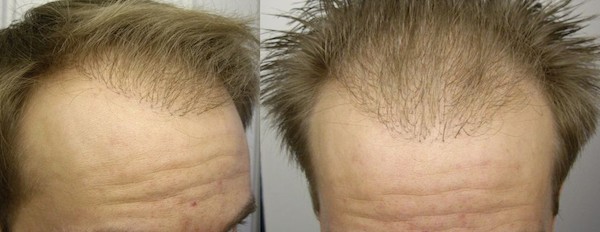
A particularly important position in hair transplant risks is occupied by the recipient area. A hairline describes the most important zone in the course of a hair transplant! The first glance of an opposite person is directed at the face and the hairline
An unnatural hairline is therefore immediately obvious and therefore the potential danger in the recipient area should be taken very seriously! Some world-renowned and renowned hair surgeons have specialized in hairline design, consulting a proven expert is worthwhile in any case! Otherwise, there is the risk of unnaturally designed hairlines (pulled too far into the face, aligned too far towards the top of the head, or laid out in an unaesthetic way in terms of the lines) and also the risk of implanting grafts that are too “thick” into the hairline or not selecting the groupings correctly. As a result, this creates unnatural “tufts” of hair, a so-called toilet brush effect, whereby nature only single hairs (FU’s of 1) grow, and thus the aesthetics of the hairline is ruined.
The skin openings (slits) in the recipient area (implantation area) should definitely be placed by an experienced hair surgeon! The implantation of the grafts (hair follicles) is also delegated to specially trained non-medical staff at some clinics. Here, too, extraordinary skills are required in order to avoid incorrect insertion, which can result in the wrong direction of hair growth, among other things. But also the arrangement and the characteristics of the grafts used (1s, 2s, etc.) play a decisive role in achieving an optically and aesthetically successful result.
low and poor growth rate
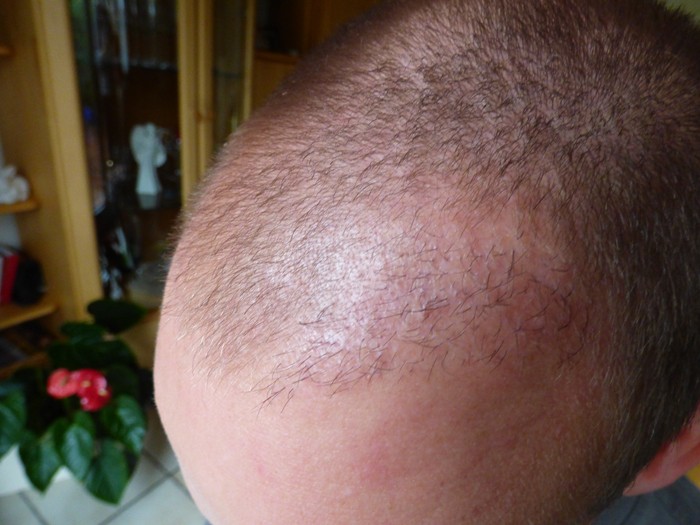
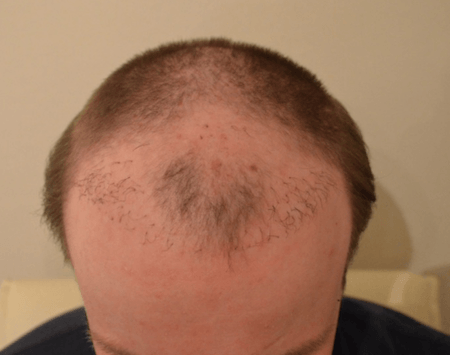
Another risk is a poor growth rate. The very delicate hair follicles require very careful handling and can be damaged in many surgical steps during the treatment, resulting in a low growth rate.
Poor growth rate due to too robust and traumatic insertion of the grafts, or due to drying out of the grafts during insertion
Often the mistakes are simply due to lack of knowledge and experience on the part of the hair surgeon or delegating important surgical steps to inexperienced staff/assistants.
For Dr. Amit Kerure of the Skin Clinic in Mumbai, a poor growth rate of the grafts can be the result of a faulty and traumatic – too robust insertion of the grafts, or due to drying out of the grafts during insertion. He further points out that a low growth rate could also be the result of poor quality donor hair, such as already miniaturized hair (vellus hair), and the doctor should assess this very carefully before the procedure and simply not operate on the patient if the conditions are poor.1
Possible negative influence of smoking and diabetes on the growth rate
He goes on to say that poor growth rates could also be caused by factors such as heavy smoking, diabetes, and excessive sun exposure to the scalp, or sometimes by non-specific individual anatomical factors.1
the unwanted side effects of cobblestoning and pitting
Cobblestoning refers to a mounding of the skin surface around the grafts. The skin is no longer smooth, but you can see optical elevations around the inserted hairs/grafts, the correct translation is “cobblestoning”. Pitting is exactly the opposite, a depression around the grafts, similar to a pit. Both create an appearance that is often psychologically distressing to patients and cobblestoning/pitting are almost always due to surgical error or when the grafts are inserted by inexperienced personnel.
Reasons for pitting and correction
According to Dr. Samuel M. Lam, MD of the Lam Institute for Hair Restoration in Plano, Texas, USA, pitting is the result of grafts being inserted too deeply. The grafts should be placed slightly higher than the skin so that the grafts are at the same level when the edema subsides. If the grafts are lower than the surrounding skin, there is a high risk/probability of pitting around the graft. Later correction is very difficult. In very obviously sensitive areas such as receding hairline and hairline, the “pits” can be removed by punch excision, and otherwise, additional grafts can be placed around the grafts to somewhat conceal the pits.2
Reasons for cobblestoning and correction
According to Dr Lam, the cause of cobblestoning in hair transplantation is exactly the opposite problem, when grafts are placed too high to the surrounding scalp.2 Likewise, if the receiving openings for the grafts are too small. Regardless of the fact that the grafts can then be damaged during insertion, the graft that is too large with too much tissue can also lead to cobblestoning and mounding. Cobblestoning is also difficult to correct, as Dr Lam mentions. The higher portion of skin can be separated flush with the scalp, or more grafts can be grafted around the existing poor grafts with mounding to conceal it.2 Whether it is a matter of correcting cobblestoning or pitting, it is always advisable to test a few grafts first.
fundamental risks of A Transplant: How experienced is the staff? Are the grafts regularly kept moist during the procedure? Many reasons for a poor overall result
It should also be clear that if, as is the case in many low-cost FUE hair factories, 4,000 or even 5,000 grafts and more are regularly removed and transplanted in a single day, many important details are probably not given sufficient attention. Important procedures may be omitted or performed too quickly and the overall hair transplant risks increase significantly.
In addition to the careful extraction of the grafts/transplants (greatest care, keeping the transection rate/damage rate as low as possible, and achieving the best possible hair count per graft), many other criteria also play an important role. For example, how long the grafts are stored outside the body, whether stage transplantation takes place (intermittent FUE), and how the grafts are treated after removal.
For example, are the harvested grafts regularly kept moist and protected from the risk of drying out? Is the insertion performed by an experienced person? The very fine FUE grafts, for example, can be damaged quickly if the person carrying out the procedure inserts the grafts too deeply or if they bump into something and get damaged. All in all, there are many criteria that should be taken into consideration so that the operation can be successful and a good growth rate can be achieved.
Transplantation risks and the issue of “flying doctors
As already mentioned elsewhere, providers, but also hair transplant agencies, often advertise a team that carries out the transplantation. There will probably be several reasons for not wanting to disclose the name of the performing doctor in advance. One of these reasons, however, seems to be that it is easier to exchange doctors or entire teams or have them flown in from abroad/overseas, each with a different personnel composition, if interested parties do not know the doctor and thus do not focus on a particular doctor. It should also be noted at this point that acting with foresight significantly reduces the hair transplant risks! Not only with regard to one’s own treatment (lack of qualification and treatment errors), but also with regard to legal action that may be taken in a given case. Transparency should be indispensable and guarantees direct contact with the treating doctor at all times – before the treatment, during it, and also after the procedure!
Fighting botched procedures and increasing hair transplant risks: The ISHRS awareness campaign “Fight The FIGHT” against assembly line work and so-called black market mass processing clinics (black market clinics)
“Many of the illegal clinics have fancy websites with testimonials and testimonials that look very professional. However, the reality is that the own hair surgery may be performed by someone who has no medical training.”
ISHRS.org “Fight The FIGHT” Campaign3

Campaign against black-market clinics
The ISHRS is an international hair surgery association with over 1000 members from 70 different countries. The ISHRS has also recognized the changing times in the industry and is concerned about the development and growing hair transplant risks to patients from unlicensed technicians, who now represent a large proportion of hair transplants performed worldwide, and has therefore launched the “Fight the fight” awareness campaign against black-market clinics and increasing numbers of botched hair transplants.

According to ISHRS, cheap prices, dubious advertising, and misleading information together with attractive all-inclusive prices (medical tourism packages) are making patients frivolous and even feel good about undergoing surgery at clinics where complete hair transplantation may be performed by non-medical persons with very little training. This seriously increases the overall hair transplant risks and poses a serious health risk and often leads to tragic consequences such as permanent scarring, infections leading to disfiguring results with very little to no possibility of correction.5
The ISHRS believes that the following steps in hair transplantation should only be performed by a licensed physician:
- Preoperative diagnostic evaluation and consultation
- Planning of the surgery
- Performing the surgery including: harvesting the donor hair, shaping the hairline design, creating the recipient sites, managing other medical problems of the patient and possible adverse reactions, post-operative care.5
According to the ISHRS4 , the black market consists of a number of rogue clinics (many based in Turkey) staffed by “non-doctors” (sometimes just a doctor to mislead patients) and facilitating illegal practices. Patients around the world suffer from the illegal actions of these clinics, including injury and scarring, overused donor areas (moth-eaten optics), or irreparable aesthetic results such as artificial-looking hairline, incorrect growth direction, cobblestoning, and pitting.5
The ISHRS has highlighted the increased hair transplant risks from such low-cost clinics with some powerful pictures of failed surgeries posted online.6
ISHRS pictures of an FUE with excessive donor removal
The negative consequences of FUE hair transplantation when too many follicular units are harvested in the donor/rim of hair, lack of knowledge about the blood supply to the skin, and the over-aggressive attempt to harvest as many grafts as possible in a very short time:
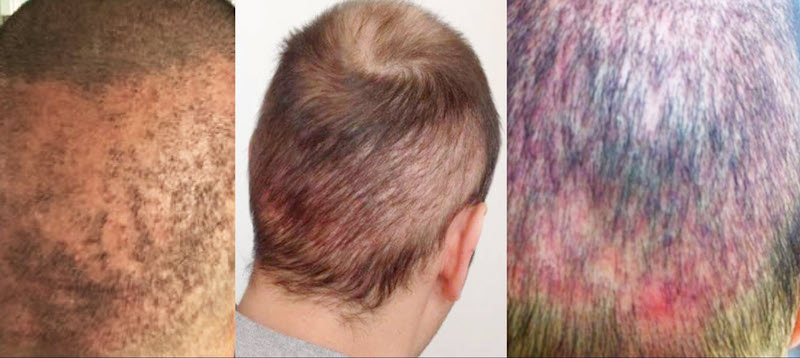
The result of extracting too many follicular units in the donor area and lack of knowledge about the blood supply to the skin and over-aggressive attempt to extract as many grafts as possible in a very short time.
ISHRS images regarding the risks of permanent scarring and thinning in the hairline/donor
Excessive extraction and trauma cause visible thinning and scarring.
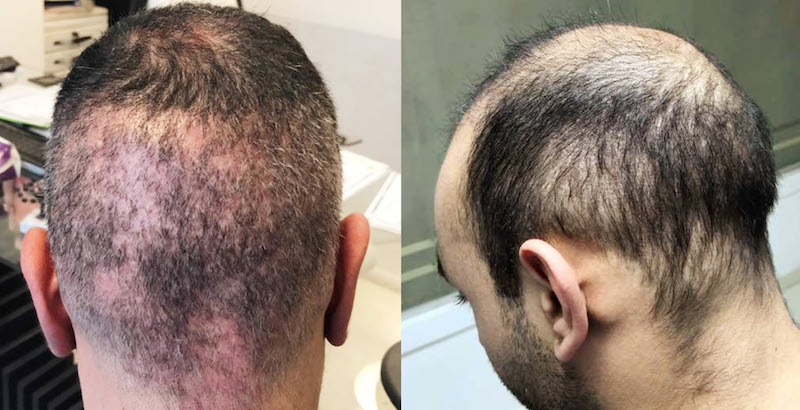
ISHRS images: Irreversible overharvesting
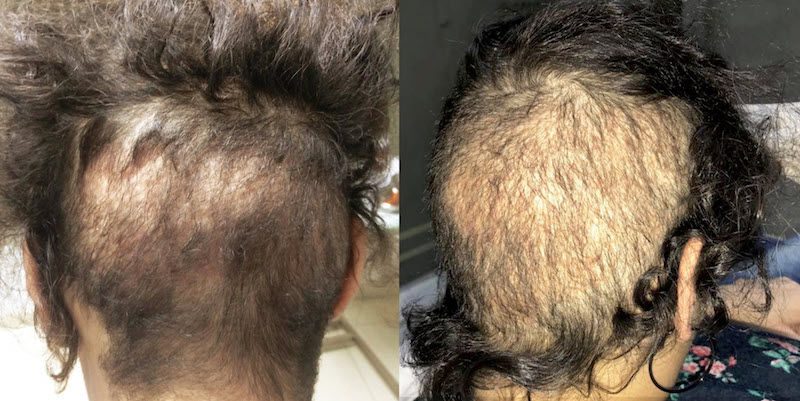
Due to lack of experience and skill, the FUE technique can also cause massive hair loss in the donor area and thinning that is not reversible in women.
Hair transplant risks: What is the likelihood of something going wrong during the procedure? No surgical procedure can be 100% guaranteed!
There are risks with a hair transplant, just as with any other surgical procedure, and they cannot be 100% excluded. But they can be limited in the best possible way if important parameters are taken into account when looking for a suitable hair surgeon. The cost of the treatment or the distance to the location of a doctor/clinic should therefore never enter into the decision. Only the choice of an excellent specialist for hair surgery can optimize the chances of a good result without complications. And should the case actually arise that a hair operation does not produce the desired result, you can assume a generous attitude of goodwill with proven specialists and you are also in the best hands in the case of follow-up treatment.
Irreversible intervention, decision with lifelong consequences and loss of further options
From the very first thought of transplantation, the particular implications of such interventions on the human body must influence all further considerations and decisions. The most suitable donor material is the patient’s own remaining hair in the crown of the back of the head. The number of donor transplants is therefore limited to the number of hairs available there. Unprofessional doctors who exploit and decimate this donor area, or who carry out a machine-assisted extraction, or who basically only achieve a low growth rate, which is based on a lack of professional and technical knowledge or unsuitable equipment, can ruin the “supply” of donor grafts. In the worst case, there are no more transplants available to have another operation performed later, which is very often necessary or desired.
The basis of every transplantation is a sufficient donor: donor hair lost forever weighs heavily, loss of donor material is irreversible!

Many prospective patients do not sufficiently realize this when it comes to choosing a hair surgeon for their own hair transplant. It is really extremely frightening when, for example, you are waiting for your flight in the airport building in Istanbul (Istanbul is practically considered a stronghold for hair transplants in the cheap segment) and tens of “patients” who have just been treated and who also want to start their journey home reveal the view of a completely ruined donor area (band of hair). One sees satisfied, often happy faces of people who obviously do not yet know what has just happened to them. Disillusionment follows later when the desired result is not achieved and downright despair will probably ensue when it turns out that no further surgery can take place because there is no longer sufficient donor material available. Many prospective donors do not realize in advance that they could end up in such a situation. The permanent and irreversible damage to the donor area (hair crown) is one of the greatest risks of hair transplantation!
Therefore, this paragraph should once again emphatically point out how final and irreversible the exploitation/ruin of the donor zone is due to a qualitatively inadequate operation – and how serious the consequences are, which in case of doubt result in a lifelong impairment.
For those interested in hair restoration with quick socialization, click here for the FUE method without any shaving.
Sources/References/Author
1 Dr. Amit Kerure, Mumbai, Mumbai, Indien https://www.jcasonline.com/article.asp?issn=0974-2077;year=2018;volume=11;issue=4;spage=182;epage=189;aulast=Kerure
2 Dr. Samuel M. Lam, MD, Plano, Texas, USA https://www.facialplastic.theclinics.com/article/S1064-7406(13)00099-0/pdf
3 https://fightthefight.ishrs.org/
4 https://ishrs.org/2019/03/04/illegal-hair-transplant/#more-6729
5 https://fightthefight.ishrs.org/about/
6 https://fightthefight.ishrs.org/beware-risks/
Author:


